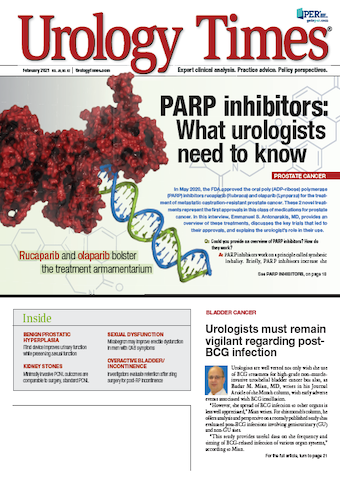Publication
Article
Urology Times Journal
Urologists must remain vigilant regarding post-BCG infection
Author(s):
"It is essential for us to be vigilant about all the complications, whether local or systemic, associated with intravesical BCG," writes Badar M. Mian, MD.
Badar M. Mian, MD

Intravesical instillation of BCG remains the most frequently utilized therapy against high-grade non–muscle-invasive urothelial bladder cancer (NMIBC). Treating urologists are quite familiar with the identification and management of early urinary and systemic adverse effects of BCG instillation. However, the spread of BCG infection to other organs is less well appreciated, likely due to the low incidence of such complications. Further, the published literature mostly consists of single-case reports. To increase awareness of these complications, Cabas et al performed a systematic review of the published literature demonstrating the frequency and timing of potentially serious post-BCG infections involving genitourinary (GU) and non-GU sites.1
To identify all case reports of post-BCG infections, the investigators systematically reviewed 401 publications through Medline and other searches. Of these, 271 case reports, including 307 patients, met the inclusion criteria for the review. From these reports, the authors compiled data including demographics, tumor grade/stage, number of intravesical instillations, number of organs with BCG infection, time from last BCG instillation to signs of infection, type of imaging utilized, microbiological confirmation, type and duration of surgical and nonsurgical treatment, and patient outcomes.
Of the 307 cases of post-BCG infection, only 4 (1.3%) occurred in female patients. The average number of intravesical BCG instillations prior to developing symptoms of infection was 8 plus or minus 5.3 instillations. A single organ/site was infected in 72.0%, 2 organs were affected 20.2%, and 3 or more organs were affected 7.8% of the cases. Of all the cases identified by the authors, including those with multiple organs involved, BCG-related infection of GU organs occurred in 23.7% and non-GU organs were involved in 76.2% of cases. Most frequently involved sites included non-GU organs such as lungs, vascular system, and liver, whereas the various GU organs (testis, penis, prostate, and kidneys) were involved equally and infrequently.
The median time from last BCG instillation to clinical signs of infection varied and depended on the organs involved. The granulomatous infection of the liver and lungs (such as miliary pulmonary infection) occurred earlier, at a median time of 1 week from the last instillation. In contrast, vascular lesions (endograft graft infection or mycotic aneurysm), bone/joint involvement (prosthetics infection or spondylodiscitis), and muscular involvement (psoas abscesses) occurred late, at a median of 52, 68, and 93 weeks, respectively. Amongst the GU organs, penile lesions (erythema, ulcer, granulomatous lesions) appeared at a median of 1 week, prostatitis or abscess at 3 weeks, renal granulomatous disease at a median of 8 weeks, and epididymo-orchitis at a median of 56 weeks.
Overall, microbiological diagnosis was made in 55.6% of cases through acid-fast stain, culture, or polymerase chain reaction test. The rate of isolation and mycobacteria identification at the affected sites also appears to be related to the organs involved. Microbiological detection was noted in 28.6% of penile lesions, 35.2% of lung lesions, and nearly 60% of prostate/epididymis/testis lesions. The highest rates of microbiological detection of the mycobacteria were noted in vascular (83.6%), bone/joint (91.7%), and muscle lesions (100%). In evaluating concomitant infections at various sites, the investigators observed a strong association (P < .001) between lungs and liver complications, bone marrow and liver complications, bones/joints and muscles, and lungs and bone marrow complications. No significant associations between concomitant infections and various GU organ sites were identified.
The reported duration of antimycobacterial therapy ranged from a median of 6 weeks for penile or testicular lesions, 8 weeks for lungs or liver lesions, and 12 weeks for bone/joint infections. Surgical intervention was most frequently required for cases of infections involving vascular (83%), bone/joint (85.4%), and muscular systems (90.5%), whereas surgical intervention was relatively infrequent for lung (6.8%) and liver (8.9%) infections.
Of the GU organs involved with post-BCG infection, a majority (55%-90%) of the penile, prostate, and kidney infections manifested within 1 month of the last BCG instillation, whereas testicular cases appeared after 12 months or longer. For the non-GU organs, there appears to be a biphasic distribution of the time to post-BCG infection. A majority (50%-75%) of the lung, liver, and bone marrow infections became apparent within 1 month. More than 50% of the infections involving vascular, muscular, and bone/joint systems appeared 12-24 months after the last BCG instillation.
An interesting observation from this compilation of 307 case reports is that only 1.3% of post-BCG systemic infections occurred in female patients. One may speculate that the male anatomy (bulbar urethra, prostate) is more prone to catheter-related trauma during instillation, followed by increased exposure of traumatized area to the BCG when voiding. Both of these would result in potential intravasation of BCG resulting in systemic spread of BCG. Thus, strict adherence to the protocol for canceling the BCG in the presence of infection, and aborting the instillation in the setting of trauma and/or any degree of gross hematuria, is required. Although systemic infections involving non-GU organs are uncommon, these infections are associated with significant morbidity, and mortality. Of the 65 cases of vascular involvement, 10 (15.4%) died of BCG-related complications. The mortality rate for the post-BCG infections involving lungs, liver, and muscles was reported to be 4.1%, 3.6%, and 4.8%, respectively.
This study provides clinically useful data on the frequency and timing of BCG-related infection of various organ systems. Urologists play a pivotal, long-term role in the diagnosis and treatment of NMIBC, and essentially serve as the primary oncologists for patients with NMIBC. It is essential for us to be vigilant about all the complications, whether local or systemic, associated with intravesical BCG. A high index of suspicion is required for early identification of these infrequent, but potentially lethal, post-BCG systemic infections.
Reference
1. Cabas P, Rizzo M, Giuffrè M, et al. BCG infection (BCGitis) following intravesical instillation for bladder cancer and time interval between treatment and presentation: a systematic review. Urol Oncol 2021;39(2):85-92. doi:10.1016/j.urolonc.2020.11.037

































